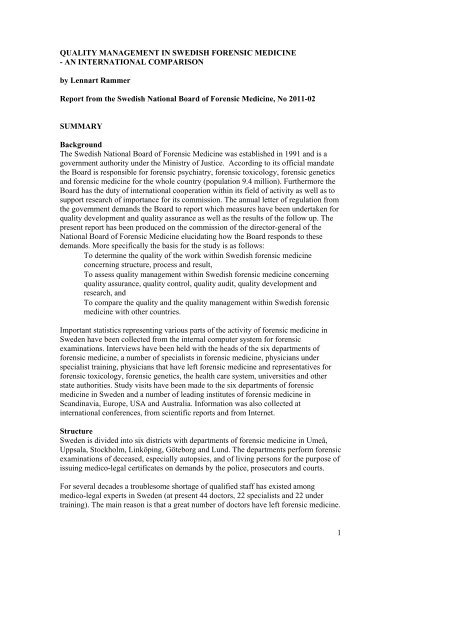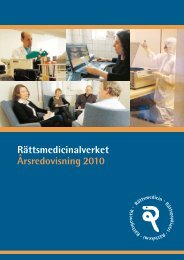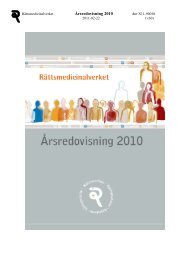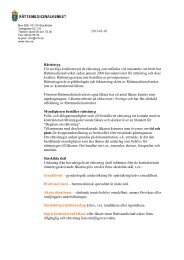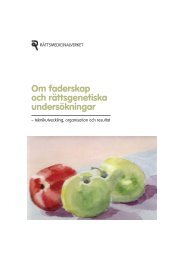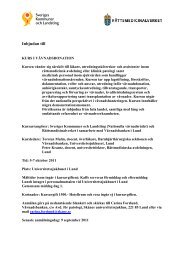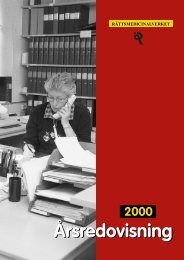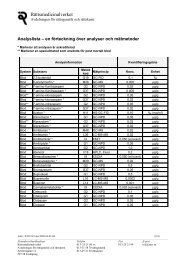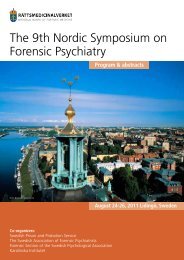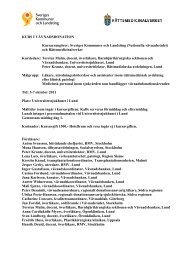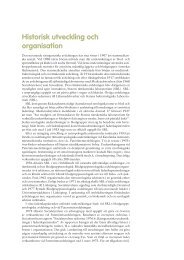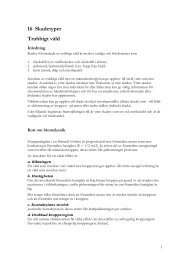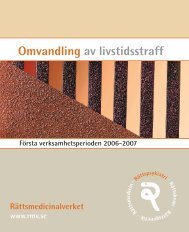QUALITY MANAGEMENT IN SWEDISH FORENSIC MEDICINE
QUALITY MANAGEMENT IN SWEDISH FORENSIC MEDICINE
QUALITY MANAGEMENT IN SWEDISH FORENSIC MEDICINE
You also want an ePaper? Increase the reach of your titles
YUMPU automatically turns print PDFs into web optimized ePapers that Google loves.
<strong>QUALITY</strong> <strong>MANAGEMENT</strong> <strong>IN</strong> <strong>SWEDISH</strong> <strong>FORENSIC</strong> MEDIC<strong>IN</strong>E<br />
- AN <strong>IN</strong>TERNATIONAL COMPARISON<br />
by Lennart Rammer<br />
Report from the Swedish National Board of Forensic Medicine, No 2011-02<br />
SUMMARY<br />
Background<br />
The Swedish National Board of Forensic Medicine was established in 1991 and is a<br />
government authority under the Ministry of Justice. According to its official mandate<br />
the Board is responsible for forensic psychiatry, forensic toxicology, forensic genetics<br />
and forensic medicine for the whole country (population 9.4 million). Furthermore the<br />
Board has the duty of international cooperation within its field of activity as well as to<br />
support research of importance for its commission. The annual letter of regulation from<br />
the government demands the Board to report which measures have been undertaken for<br />
quality development and quality assurance as well as the results of the follow up. The<br />
present report has been produced on the commission of the director-general of the<br />
National Board of Forensic Medicine elucidating how the Board responds to these<br />
demands. More specifically the basis for the study is as follows:<br />
To determine the quality of the work within Swedish forensic medicine<br />
concerning structure, process and result,<br />
To assess quality management within Swedish forensic medicine concerning<br />
quality assurance, quality control, quality audit, quality development and<br />
research, and<br />
To compare the quality and the quality management within Swedish forensic<br />
medicine with other countries.<br />
Important statistics representing various parts of the activity of forensic medicine in<br />
Sweden have been collected from the internal computer system for forensic<br />
examinations. Interviews have been held with the heads of the six departments of<br />
forensic medicine, a number of specialists in forensic medicine, physicians under<br />
specialist training, physicians that have left forensic medicine and representatives for<br />
forensic toxicology, forensic genetics, the health care system, universities and other<br />
state authorities. Study visits have been made to the six departments of forensic<br />
medicine in Sweden and a number of leading institutes of forensic medicine in<br />
Scandinavia, Europe, USA and Australia. Information was also collected at<br />
international conferences, from scientific reports and from Internet.<br />
Structure<br />
Sweden is divided into six districts with departments of forensic medicine in Umeå,<br />
Uppsala, Stockholm, Linköping, Göteborg and Lund. The departments perform forensic<br />
examinations of deceased, especially autopsies, and of living persons for the purpose of<br />
issuing medico-legal certificates on demands by the police, prosecutors and courts.<br />
For several decades a troublesome shortage of qualified staff has existed among<br />
medico-legal experts in Sweden (at present 44 doctors, 22 specialists and 22 under<br />
training). The main reason is that a great number of doctors have left forensic medicine.<br />
1
During the last 10 years 34 doctors have disappeared, 19 specialists and 15 doctors<br />
under education have left for other duties. This corresponds to an annual loss of nearly<br />
10 percent of the entire group. This shortage of staff is absolutely the most important<br />
problem in Swedish forensic medicine at the present time.<br />
The main reason for the problem is a feeling among many pathologists that the work is<br />
tedious and too demanding and gives little possibility for professional development and<br />
stimulation. The heads of the departments are responsible for organizing the workload<br />
so that the situation can be improved. The National Board of Forensic Medicine has<br />
created an ambitious plan with a 10-year perspective with major focus on recruitment<br />
and education of doctors. The goal is that by 2018 there will be 71 pathologists within<br />
Swedish forensic medicine. Creation of a stimulating intellectual environment at the<br />
departments with seminars, case discussions and research projects as well as carrier<br />
planning with sub specialization is probably of decisive importance in order to<br />
encourage physicians to remain active in the field.<br />
University affiliation exists at four of the six departments in form of professorships in<br />
forensic medicine in Umeå and Uppsala and lectureship in Stockholm and Lund.<br />
During a period in the 1990s all six heads of the departments were professors and<br />
specialists in forensic medicine. The change reflects increasing competition for<br />
permanent appointments within the university system and decreased activity in forensic<br />
medicine with regard to basic research and scientific publications. The National Board<br />
therefore should concentrate on financing adjunct university positions in forensic<br />
medicine, in the same way as in forensic toxicology, genetics and psychiatry.<br />
The current heads of the departments of forensic medicine have a somewhat different<br />
educational background. Three of them are medico-legal experts, of whom one is a<br />
medical doctor, and three of them are not. Of the three non-medically qualified<br />
individuals, two have an education as laboratory technicians and one as a lawyer. At the<br />
three departments where the heads are not qualified in medicine, a forensic pathologist<br />
is made responsible for the medical activities as a medical head of the department. Two<br />
departments lack an assistant head of the department, which is regrettable. A more<br />
uniform and competence oriented solution of the management of the departments<br />
would be desirable. At all departments the leadership should consist of two persons,<br />
one head and one assistant and deputy head of the department, who together should<br />
provide skills in leadership, administration, medicine and research. The main<br />
alternative is that the head of the department should be a specialist in forensic medicine.<br />
A new category of personnel recently introduced by the National Board of Forensic<br />
Medicine is so-called medico-legal death investigators. These individuals are trained as<br />
nurses or similar occupation and their task is to have a dialogue with relatives of the<br />
deceased. This might entail an assessment of the medical and social background of the<br />
deceased before the forensic autopsy is performed and on request to inform the relatives<br />
about the results of the autopsy. This is an important professional category to maintain<br />
and develop further.<br />
The departments of forensic medicine generally have buildings and facilities well suited<br />
for their intended purpose. The department in Göteborg will undergo reconstruction in<br />
1912 to create more space for its morgue and autopsy work. During 2011 enlargement<br />
2
of the department in Stockholm has started. Also other departments will need larger<br />
localities to house rooms for an increased number of medico-legal experts.<br />
The departments are also well equipped for histopathological and other related<br />
laboratory work. All departments should have access to a car for official duties.<br />
One of the strongest operational areas of the National Board of Forensic Medicine is<br />
the computerized data system. Shortly after the establishment of the Board in 1991 the<br />
case management system “Rättsbase” was introduced for registration and follow up of<br />
medico-legal examinations. The system was used both for case registration, typing of<br />
reports, recording of diagnoses and producing statistics based on the case material. It<br />
was also connected to the system “Toxbase” for the post-mortem toxicological results.<br />
The computer activities now progress into a new generation with the introduction of the<br />
“Portal” which is a module based case registration system built in JAVA-language, and<br />
a management system for all IT-activities, LEDOK. The IT-system of the National<br />
Board of Forensic Medicine has received attention internationally and is used by the<br />
Institute of forensic medicine in Oslo, Norway. The organization with one state<br />
authority for forensic medicine in Sweden has facilated the creation of a uniform<br />
computer system for the whole forensic medicine and forensic toxicology organization<br />
throughout the country, which is a unique situation.<br />
Medico-legal examinations of deceased<br />
The number of medico-legal autopsies has remained remarkably constant at about<br />
5 500 cases a year since the establishment of the National Board in 1991. Of these cases<br />
about 200 are so called “detailed medico-legal autopsies”, where the death is suspected<br />
to have been the result of a violent crime. About 20 cases consist only of an external<br />
post-mortem examination with samples taken for toxicological analysis. In about 50<br />
cases a year, mostly when a criminal offence e.g. murder is suspected, the medico-legal<br />
expert is instructed by the police to examine the body at the scene of death. Such cases<br />
as well as the need to perform examinations of living persons at short notice motivate<br />
creating an emergency service of doctors outside normal working-hours.<br />
Forensic autopsies are quantitatively the dominating part of the workload of the<br />
departments of forensic medicine, and the work is generally of good quality. The<br />
autopsies are generally performed as complete autopsies and include a careful external<br />
examination, removal and examination of all internal organs, extensive sampling of<br />
body fluids for toxicology and any special analyses required. Microscopical<br />
examination is performed in between 60 and 90 percent of all cases with an average of<br />
75 percent. The equipment and methods used for microscopic examination is<br />
approximately the same in all departments and in general the same staining methods are<br />
used. The quality is good.<br />
Forensic toxicological examination is the other main type of special investigation after<br />
a forensic autopsy. Nearly all cases (95 percent) are subjected to the determination of<br />
alcohol and prescription drugs and often the analysis of illicit drugs and other<br />
substances of interest. The analyses are made at the Department of Forensic Genetics<br />
and Forensic Toxicology in Linköping. The quality of sampling, handling, analyses of<br />
biological fluids is well standardized and reports are issued in each case. The<br />
Department of forensic toxicology has a database of normal, toxic and lethal<br />
concentrations of drugs that has attracted attention internationally. Forensic toxicology<br />
is perhaps the strongest aspects of Swedish forensic medicine. Important areas for<br />
3
future development include use of biochemical markers of disease and new methods for<br />
determining new pharmaceutics and drugs of abuse. Another important area is regular<br />
case seminars between toxicologists and medico-legal experts, possibly through videoconferences,<br />
for discussion of results of forensic toxicological findings.<br />
A new spectacular area in forensic autopsy work is computer tomography, CTexamination.<br />
Three-dimensional X-ray pictures are taken of the whole body and are<br />
examined and evaluated before the autopsy is performed. Through cooperation with a<br />
radiological department at the university hospitals all the six departments of forensic<br />
medicine during the last years have performed such examinations. Types of cases<br />
subjected to examination are the specially detailed forensic autopsies when deaths were<br />
the result of a violent crime, deaths in children, burn victims, traffic fatalities and<br />
drowning. No department has so far purchased a CT-equipment for sole use in forensic<br />
pathology. The National Board in 2009 set up a committee to investigate the need and<br />
possibilities for such a technique in the country. The group has recommended that CTinstrumentation<br />
should be purchased at all departments of forensic medicine, starting in<br />
Stockholm and Uppsala. The director-general of the Board recently decided that the<br />
first CT-apparatus would be placed in Uppsala. This is an important area of<br />
development that should be given top priority. Equally important, however, is the<br />
consideration of professional competence by those responsible for operating the<br />
equipment. This will demand recruitment of X-ray technicians, diagnostic radiologists<br />
and a team leader responsible for the whole CT-project.<br />
In addition to forensic examinations of living and deceased persons the forensic<br />
departments in accordance with the instructions are allowed to perform other<br />
commissions within their field of competence if the workload permits, i.e. clinical<br />
autopsies and procurement of tissues after donation. Such activities are performed at<br />
some of the departments.<br />
When writing forensic reports the contents and conclusions are the most important,<br />
but the design and formulation of the language are also critical for the reader to grasp<br />
the meaning and understand the results. In the 1990s a common uniform design of the<br />
medico-legal reports was established, but the present survey shows that a great<br />
variation in the layout and sentence structure still exists between different departments<br />
and also between individual pathologists within the same department.<br />
The turn-around-time from receipt of a body to reporting back the results of the autopsy<br />
to the police authorities averages about two months with some small variation between<br />
the six departments. This is an unacceptably long time. The explanation generally given<br />
is shortage of pathologists, but the handling time is primarily a question of organization<br />
and prioritizing of different activities. The National Board should set up time limits for<br />
completion of forensic cases and strive to ensure that these limits are kept. Even the<br />
time from the death to the autopsy is too long depending on a slow handling of the<br />
cases by the police authorities and limited capacity at the mortuary at one department.<br />
Forensic pathologists are often required to serve as medico-legal expert witnesses in<br />
court in important cases. The formalities for this type of work are extremely variable,<br />
apparently arbitrary, which hampers the appearance in court by the medico-legal expert.<br />
4
Judicial death investigation<br />
The purpose of a medico-legal death investigation is to disclose, examine and exclude a<br />
crime as a cause of death. A Swedish study has shown that eight percent of all murders<br />
were detected at a forensic autopsy, which corresponds to up to ten cases a year in the<br />
country. The measures of the society to fulfill this purpose are a police investigation<br />
and a medico-legal examination of all suspected unnatural deaths, i.e. deaths by injury<br />
and intoxication. Recent cause of death statistics from the National Board of Health and<br />
Welfare show that only 55 percent of unnatural deaths are subjected to a forensic<br />
examination. This means a considerable risk that deaths involving crime can pass<br />
undetected. The National Board ought to raise the question with the National Board of<br />
Health and Welfare of reporting deaths to the police.<br />
On the other hand a considerable number of forensic autopsies are performed that more<br />
correctly should have been completed within the normal medical service, either as a<br />
clinical autopsy or without an autopsy. These cases ought to have been brought back to<br />
the reporting doctor after consultation between the police and a medico-legal expert.<br />
Other cases correctly reported to the police could have been completed with an external<br />
medico-legal examination, being sufficient to answer questions about the cause of death<br />
and the manner of death. If the medico-legal expert after making such an examination<br />
considers there are remaining questions to answer then a complete forensic autopsy<br />
should be performed. A survey of a number of forensic examinations shows that<br />
approximately 5-10 percent of the cases could have been brought back to the health<br />
services and 20 percent could have been completed with only an external medico-legal<br />
examination.<br />
The transports of bodies from a place of death to a department of forensic medicine and<br />
back is arranged and paid for by the police authorities and carried out by various<br />
undertaker companies. However, a number of problems exist in relation to these<br />
transports, especially concerning security, and therefore it has been suggested that the<br />
National Board of Forensic Medicine should take over this responsibility. However, at<br />
longer distances it is difficult to arrange the transports directly from the departments of<br />
forensic medicine and to achieve full covering of the costs. The main alternative,<br />
therefore, should be that the police also in the future takes the responsibility for the<br />
transports of bodies. The security questions should be considered after discussions with<br />
the National Police Board.<br />
Identification of bodies after mass disasters is regulated by the instruction for the IDcommission<br />
and according to international regulations. Specific regulations, however,<br />
are lacking for identification of single cases of death within the country and the police<br />
decide in each specific case if the body can be considered identified with sufficient<br />
certainty. There are examples of deaths in which the body has undergone severe<br />
putrefaction and has been identified by belongings or by resemblance with a<br />
photograph. Regulations should be formulated such that when there is any doubt about<br />
identity, this should be established with full certainty by odontological, genetical or<br />
fingerprint method. The question should be discussed further with representatives of the<br />
National Police Board.<br />
In deaths resulting from medical negligence or maltreatment, these should be reported<br />
to the National Board of Health and Welfare, and also to the police authorities. Often<br />
reporting to the police is omitted, and the number of forensic autopsies in such cases is<br />
5
only about 20 per year, while the number of deaths reported to the National Board of<br />
Health and Welfare exceeds more than 100. The discrepancy in these numbers needs to<br />
be discussed with the National Board of Health and Welfare, and appropriate measures<br />
taken.<br />
Medico-legal certificates<br />
In 2006 a new law and a new order appeared concerning the issuing of judicial<br />
certificates. The National Board of Forensic Medicine was made responsible for<br />
providing these certificates and contracted about 50 doctors (forensic physicians) who,<br />
together with the medico-legal experts at the departments of forensic medicine, would<br />
issue the certificates. A follow up of this reform showed that the new order had resulted<br />
in certain improvement in the quality of the certificates, but that a number of problems<br />
still remained.<br />
The number of certificates issued remains low at about 8 000 per year compared to<br />
120 000 cases of physical and sexual assault reported to the police. The costs of the<br />
examination have to be covered by the police budget, which might account for the low<br />
number of victims actually examined. The majority of the certificates are opinions<br />
about medical records and is not based on de facto medico-legal examination of the<br />
person. Often the police demand only a copy of the medical record instead of a<br />
certificate without cost for the police. The law about judicial certificates deals only with<br />
issuing these certificates and not with the physical examination of the person.<br />
Regulations are also lacking concerning when and how certificates should be ordered<br />
by the police and prosecutors. These questions should be discussed with the National<br />
Police Board and the Prosecutor-General.<br />
The quality of the training of the forensic physicians needs to be improved. Presently,<br />
the basic training includes two days of instructions, which has to be extended.<br />
Instructions should also be given when the physicians come to the departments of<br />
forensic medicine for individual review of cases. There is a need for internal quality<br />
control of the certificates performed by a medico-legal expert prior expedition of the<br />
reports. A question to consider in the long run is if the main part of the activity<br />
involving clinical forensic medicine should be taken over by the medico-legal experts<br />
within the departments of forensic medicine. Exceptions where forensic physicians still<br />
have to be used would be when there are long distances to travel to the nearest<br />
department of forensic medicine.<br />
According to the previous presentation there is a number of areas concerning both death<br />
investigations and clinical forensic medicine, where discussions with the National<br />
Police Board, the Prosecutor-General and the National Board of Health and Welfare are<br />
necessary. From an efficiency aspect these discussions ought to be conducted in form<br />
of projects during short periods of time and not through regular annual meetings.<br />
Quality management<br />
Quality assurance was early instituted in Swedish forensic medicine. Already at the<br />
beginning of the National Board in 1991 regulations about medico-legal examinations<br />
of deceased were introduced. Before a Scandinavian conference about quality assurance<br />
in forensic medicine and forensic toxicology in Göteborg in 1993 a “ Basis for national<br />
guidelines in forensic medicine and forensic toxicology” was issued. The document<br />
was promoted to internal guidelines in 1994 as a professional support in performing<br />
6
forensic autopsies. In 2003 a modernization of these guidelines was instituted, and in<br />
2007 they were revised into a method manual. After a certain uncertainty about its<br />
introduction this manual has constituted the basis for a new quality project within<br />
Swedish forensic medicine. Apart from these documents a number of internal<br />
guidelines exist regulating parts of the activity with medico-legal examinations. These<br />
guidelines are not complete, were produced fairly long ago and are under revision. In<br />
1998 a group was appointed responsible for the quality management in forensic<br />
medicine, consisting of the heads of the departments, under the leadership of a senior<br />
medico-legal expert. In 2001 this group was reorganized to a board for quality<br />
development with representation from various categories of personnel.<br />
In the beginning of 2009 one head of department was appointed as a quality coordinator<br />
and convener of a project group “Quality in forensic medicine”. This project has the<br />
purpose to result in a system for quality management and intended accreditation<br />
according to ISO/IEC 17025 and 17020 through SWEDAC for medico-legal<br />
examinations of deceased and living persons for the whole country. Representatives of<br />
various categories of personnel cooperate in working groups. Medico-legal experts are<br />
not particularly represented, which is a severe drawback that should be considered and<br />
taken care of. A reference group consisting of the heads of the departments and the<br />
medical heads are responsible for the medical part of the project.<br />
The work with quality assurance within Swedish forensic medicine and introduction of<br />
a system for quality management and intended accreditation through SWEDAC is<br />
positive and of importance to generate a high and even quality of the medico-legal<br />
examinations. When the project is finished a specialist physician in forensic medicine<br />
should be appointed as a technical leader and responsible for the quality system of<br />
medico-legal examinations.<br />
External control of the quality management system will be done by SWEDAC in case<br />
of an accreditation. External audit of the medico-legal examinations and reports have<br />
on some occasions been performed by representatives from the National Board of<br />
Health and Welfare and within forensic medicine through alternate inspection between<br />
the departments. It is desirable that within the framework of the quality management of<br />
forensic medicine a system of external audit is constructed concerning handling,<br />
procedure, interpretation and documentation of single cases of examination. This could<br />
be preformed by an external specialist in forensic medicine, e.g. from another<br />
Scandinavian country or previously active in Swedish forensic medicine. Apart from<br />
the description of methods within the accreditation documents, the selection of methods<br />
for various types of cases should also be indicated in the system.<br />
Internal quality control presently is performed according to “Guidelines for quality<br />
assurance at the departments of forensic medicine”. Two doctors, one examining and<br />
one controlling physician should perform the so-called ”Detailed forensic autopsy”.<br />
Other cases of forensic autopsy should be performed by one doctor, and in these cases<br />
the report should be controlled by another doctor. For the moment the National Board<br />
considers after consultation with the National Police Board to abandon the type of<br />
autopsy called “Detailed forensic autopsy”, as it is not mentioned in the Autopsy law.<br />
In this case it is important to keep the procedure with two doctors in cases with<br />
apparent or suspected crime in accordance with the recommendation of the European<br />
7
commission. The procedure with two doctors performing the autopsy should be used<br />
more flexibly, also in other types of difficult cases after decision of the medical head.<br />
According to its instruction the National Board of Forensic Medicine is expected to<br />
support research of importance for its commission. This is done by administration of<br />
funding for research projects, creation of contracts with universities, financing of<br />
positions as adjunct professors and lecturers and allowing time for research work. The<br />
amount of money allocated for research projects is decided annually and amounts to<br />
about 1 million SEK (100 000 Euro). On a central level a director of research<br />
administers the activities.<br />
The total level of the research activities at the departments of forensic medicine is on<br />
the whole fairly good, considering the limited size of the organization and extensive<br />
routine work. Troublesome, however, is that some departments are almost totally<br />
lacking research activities, that the research activity is declining and that with a few<br />
exceptions no doctors within forensic medicine are registered as postgraduate students.<br />
The National Board, however, has an ambitious research policy. Of importance is that<br />
the research activity of the departments more clearly should be organized in research<br />
groups with defined projects lead by a project leader and tutors. Connection to the local<br />
universities is important to accomplish registration of postgraduate students and in the<br />
long run elevation of the level of quality of the research of special importance for the<br />
commission of forensic medicine.<br />
Borttaget: <br />
International comparison<br />
As part of the present project a number of leading institutes of forensic medicine were<br />
visited, both in Europe and previously also in USA and Australia. The purpose was to<br />
document and learn about the organization and procedures used and to compare quality<br />
and quality management of Swedish forensic medicine with other countries. Generally<br />
the quality of forensic medicine in Sweden is high by international standards. Strong<br />
areas are the core commission as forensic autopsies and forensic examinations of living<br />
persons, histopathology and above all forensic toxicology, where a central accredited<br />
laboratory is available. Even national efforts within specialist education and the<br />
computerized system are strong areas of the current system. Ongoing projects including<br />
CT-diagnostics and accreditation of forensic medicine will help to bring Swedish<br />
forensic medicine on par with leading institutes in other countries. Problem areas are<br />
the recruitment of the medico-legal experts and to encourage them to remain within the<br />
organization, the quality of the reports by the contracted forensic physicians and the<br />
low research activity of some departments.<br />
In this report special attention has been given to legislation in other Scandinavian<br />
countries in the way unnatural deaths are dealt with within the legal field. The<br />
legislation is clear and coherent in Denmark and Finland, while it is less clear and<br />
disparate in Norway and Sweden. The Danish Health law has a structure with three<br />
levels 1) A medical external examination performed by a doctor in all out-of-hospital<br />
deaths, 2) A forensic external examination performed by a county medical officer or a<br />
medico-legal expert in all deaths reported to the police and 3) A forensic autopsy<br />
performed by a medico-legal expert in special cases of death. The Law on investigation<br />
of the cause of death in Finland separates 1) Medical investigation of the cause of death<br />
8
and 2) Forensic investigation of the cause of death, with the special types of<br />
investigation, medical autopsy and forensic autopsy.<br />
A new order for judicial investigation of death<br />
There is reason to improve the Swedish system for investigation of deaths within the<br />
legal field to guarantee that all deaths caused by crime shall be disclosed. Thus all<br />
deaths resulting from injury or poisoning must be reported to the police for<br />
investigation and forensic examination. At the present time only 55 percent of such<br />
deaths are subjected to a medico-legal examination. In that way several deaths by crime<br />
risk to pass undetected every year. Good examples of organizational solutions of this<br />
question are the Danish system of forensic external examination, the American medical<br />
examiner system and especially the system with preliminary examination used in<br />
Victoria, Australia.<br />
To meet this purpose the following changes of the routines should be considered:<br />
Physicians should report to the police all deaths suspected to be caused by<br />
injury or intoxication.<br />
The police should decide that a forensic examination of the body should be<br />
performed in all deaths properly reported to them.<br />
Medico-legal experts at the National Board of Forensic Medicine should decide<br />
whether an external examination of the body or a complete autopsy should be<br />
performed.<br />
Deaths in hospital with good medical documentation after accidents with known<br />
course of events can be closed without further examination of the body after<br />
consultation between the police and a medico-legal expert.<br />
The above changes can be effected within the framework of the present legislation.<br />
Reporting of deaths to the police by the health organization can be improved by a more<br />
distinct formulation of the death certificate and by revision of the regulations by the<br />
National Board of Health and Welfare. The decision by the police authorities to request<br />
a forensic examination can be improved by a more stringent application of the internal<br />
rules of the police. The choice of type of forensic examination is a question for the<br />
National Board of Forensic Medicine, as this issue is not commented upon in the<br />
Autopsy Law.<br />
If the above suggested changes are made, one can expect an increase in the total<br />
number of forensic examinations from about 5 500 per year to about 7 000 per year.<br />
However, the number of forensic autopsies will decrease from about 5 500 cases to<br />
about 4 000 cases a year. An addition of about 2 000 external forensic examinations<br />
will follow, a type of examination which is not much used today. About 1 000 cases<br />
can be closed by a medico-legal expert and the police using information from the<br />
medical records. This is valid primarily for accidental deaths, such as falls, with welldocumented<br />
course of events. These figures must be read as gross approximations.<br />
Contact is needed between the National Board of Forensic Medicine, the National<br />
Police Board and the National Board of Health and Welfare with the aim to initiate<br />
changes in the routines for unnatural death investigations. If it turns out that these<br />
changes cannot be realized or don’t give the expected result, changes in the legislation<br />
should be considered. In an official letter from the National Board of Forensic<br />
Medicine to the Ministry of Justice in 2003 the Board proposed a change in the Burial<br />
9
Law as follows: “The police authority shall inform the Taxation authority about the<br />
case of death and after (the investigation that is needed) police investigation and a<br />
forensic examination deliver the death certificate to the Taxation authority together<br />
with permission to interment or cremation”. Such a change would ensure that a forensic<br />
examination in any form, whether external examination or autopsy, would be<br />
performed in all deaths reported to the police.<br />
Finally it is worth considering the need for a more logical and coherent new “Law of<br />
Death Investigation”. This should include the rules in the Burial Law about death<br />
certificate, cause of death certificate and reporting of deaths to the police and in the<br />
Autopsy Law about clinical autopsy, forensic external examination and forensic<br />
autopsy. The further regulation about reporting to the police today to be found in the<br />
regulations by the National Board of Health and Welfare should be elevated to the law.<br />
A suggested disposition would be to have one section dealing with clinical death<br />
investigation comprised of the external clinical examination and clinical autopsy and<br />
one section about the forensic death investigation consisting of external forensic<br />
examination and forensic autopsy. The suggested new disposition would then be similar<br />
to the Danish and Finnish legislations.<br />
Borttaget: <br />
<br />
<br />
10


